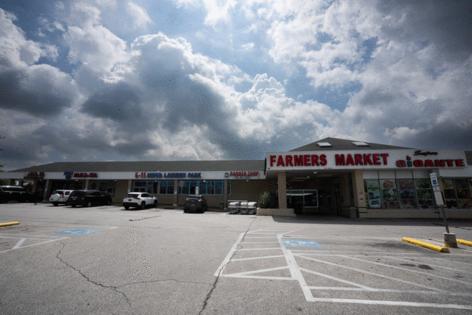Chasing ICE: 'Rapid-response' activists follow agents, then stand up for immigrants during arrests
Published in News & Features
PHILADELPHIA -- When ICE agents headed out to raid the Super Gigante food market in West Norriton this summer, they didn’t travel alone.
Following behind them were cars carrying members of the Montgomery County Watch rapid-response team, immigration activists who work to find and follow the Immigration and Customs Enforcement. Their goal: to record agents’ activities, to alert people to protest at the scenes of arrests, and, at times, to loudly confront the officers.
The group had discovered ICE agents and cars gathering that July morning in the parking lot outside the Plymouth Meeting Regal Cinema movie theater.
From there it was 4½ miles to the supermarket. The two groups arrived nearly simultaneously.
As ICE arrested 14 people for immigration offenses, activists yelled at and questioned the masked agents, asking if they told their children that they worked separating families.
“Show your face! Show your face!” they demanded.
“Get back!” an ICE agent shouted as a woman in sandals and a T-shirt approached him.
“Cowards!” came the rejoinder.
The agents did not respond to the taunt.
“They’re trying to do this quietly, they’re trying to do this when nobody is watching” ― and the rapid-response team aims to ensure that doesn’t happen, said Stephanie Vincent, an organizer who was among those who went to the supermarket that morning. “The citizens are front line right now.”
The volunteer teams are part of a growing on-the-ground resistance to the increase in ICE activity across the region.
Advocates travel Philadelphia-area highways and interstates, looking for ICE, and particularly checking big parking lots where agents might be setting up for an operation.
Activists also have established a series of county-level hotlines, enabling people to report ICE sightings. Lines are set up for Philadelphia, Montgomery, and Delaware Counties, Centre County, Lehigh and Northampton Counties, and in the combined area of York, Lancaster, Adams, Dauphin, and Franklin Counties.
The response in Montgomery County, where the county seat of Norristown has been an Immigration and Customs Enforcement target, has been perhaps the most visible. At least 62 immigrants have been arrested countywide since the end of May, advocates say.
“People are showing up and protesting, to show we support [migrants] and don’t want them taken out of the community, and asking ICE to think about what they’re doing,” said Rachel Rutter, executive director of Project Libertad, a Phoenixville-based organization that assists immigrant families. “It’s a direct response to the increase in enforcement.”
ICE officials said the agency respects people’s constitutional right to peacefully express their opinions.
“That being said, ICE remains committed to performing its immigration-enforcement mission consistent with federal law and agency policy,” a spokesperson in Philadelphia said. “These ‘rapid response teams’ will not deter ICE from completing its mission. Any interference with federal law enforcement officers in the commission of their official duties is a federal crime.”
Rapid response is not confined to the Philadelphia area. Immigrant advocates in states including California and Colorado work to spot ICE undercover cars, often SUVs with tinted windows, and some places have also established hotlines.
The First Amendment generally protects the right to watch and record police activities in public, but “approaching anyone during an enforcement action is inherently risky,” said Morgan Bailey, a former senior official at the Department of Homeland Security.
Activists may not know the full context of an operation, including those that might involve a dangerous suspect or a weapon. And ICE officers might perceive the unexpected appearance of a third party as a threat, she said.
“Even well-meaning interventions can lead to escalation,” said Bailey, now a partner at the international law firm Mayer Brown. “Unintended consequences can affect the activists, officers, bystanders, and the very individuals the activists seek to help.”
In August, Department of Homeland Security officials announced the arrest of a driver who they said tried to run over a Border Patrol agent in Maine. That, DHS said, followed incidents in which a threatening letter containing a white powdery substance was sent to an ICE office in New York City; a man who authorities say sought to stab an ICE officer was arrested in San Francisco; and a bomb threat was made against an ICE facility in Dallas.
In a statement, Homeland Security blamed “months of smears and rhetoric by activists, politicians, and the media comparing ICE law enforcement to the Nazi Gestapo, kidnappers, and the Secret Police. This shameful rhetoric has fueled a culture of hate against law enforcement.”
All this comes as President Donald Trump presses his effort to arrest and deport millions of immigrants, enforcement that is being felt across the Philadelphia region.
The number of people arrested by ICE in Pennsylvania, New Jersey, and Delaware surged after Stephen Miller, White House deputy chief of staff, said on Fox News in late May that the agency would set a quota of 3,000 arrests a day. Arrests doubled from an average of 26 a day from January through May 21 to an average of 51 a day between May 22 and June 26, recent government data show.
The number of immigrants held in ICE detention in Pennsylvania and New Jersey was up about 68% in July compared with the start of the Trump administration in January.
Even before the raid at Super Gigante, some Montgomery County commissioners aired concerned about the prospect of residents confronting ICE during arrests.
“Please, do not put yourself or anyone at risk,” Chair Neil Makhija pleaded at a board meeting in June, soon after the first wave of ICE arrests commenced in Norristown. “Do not engage in a physical confrontation or anything close to that. … We don’t want to see something tragic happen.”
Rapid-response activists say they never attempt to physically disrupt ICE. Instead, they try to record on their phones as arrests unfold, and take notes according to a protocol known as SALUTE: The Size of the ICE force, its Activity, specific Location, Unit markings and license plates, the Time, and the Equipment being used.
“When people are being snatched off of the streets, out of their jobs and their homes, there’s a sense we need to protect each other,” said Natalia Naranjo, a rapid-response activist who works mostly on hotlines and translations.
On that summer day in Norristown, two team members actually arrived at the supermarket slightly ahead of ICE, said Andi Laudisio, a team member.
“We found them in the morning, and followed them there,” she said. “We had been checking parking lots.”
She had trailed ICE in the past, she said, though the market raid was the first time she witnessed an arrest.
“We are just legal observers,” Laudisio said. “Some are only taking video and pictures, others start being loud.”
Is the strategy effective?
“I think so,” she said. “I think the community feels a little bit safer knowing we’re out there. … We are getting people who are like, ‘I’ll do rapid-response work,’ who were at first like, ‘I don’t want to be out on the streets.’”
Project Libertad has been increasing its effort to assist family members, the children and spouses traumatized by the sudden arrest and loss of a loved one who may be the main provider. The project has offered direct financial support as well as information on how to find an attorney and navigate the legal system.
Organizer Vincent said rapid response is growing at a key time, with ICE emboldened and local leaders often responding to that challenge through traditional political channels.
“We’re at this precipice,” she said. “The ICE force is only going to grow. The activity, and who they target, and what they do, is only going to get worse.”
____
Staff writer Katie Bernard contributed to this article.
©2025 The Philadelphia Inquirer, LLC. Visit at inquirer.com. Distributed by Tribune Content Agency, LLC.












Comments